With the UEFA Champions League finals in the books, most professional teams are either returning to play or in their preseason.
At the youth level, many clubs have returned to play, many under some form of restriction. Speaking with coaching colleagues, the range I’ve encountered goes from zero cross-contamination to full contact. While the later isn’t an issue, the former definitely complicates a coach’s session. Even if some level of contamination is allowed, restrictions have reduced many coaches to passing patterns and ball manipulation work.
This coaching article is a tactical analysis of sorts. Rather than focusing on the tactics of the game, our concern is improving our coaching tactics under COVID-19 restrictions. This article offers exercises for three levels of restrictions, zero cross-contamination, ball contamination without person-to-person contact and soft contact.
Zero cross-contamination
Just a few weeks ago, a friend from California was describing the coaching during COVID-19 at his club. His club’s tactics were to cut off all contact and use the “pod approach”. What’s that? Taking inspiration for a whale pod, a social group that travels and acts together, this approach is ground-zero for football training. Each player in the small group had a specific cone for their participation location, ball and water bottle. The advantage here is that if one player comes down with the virus, you’re not shutting down the entire club, just one pod.
Since there’s a zero-tolerance policy for cross-contamination, the obvious downside is that you won’t do any football training. Sessions require one ball to one player (no sharing) and strict enforcement of social distancing. With these strict requirements, ball manipulation and fitness are the only “on the pitch” training you can run. If you’re coaching under these conditions, ball manipulation coaching programs like Beast Mode Soccer offer some high-intensity, advanced level drills.
If you’re in the pod format, ball manipulation and fitness are best since you’re required to keep movement limited. For teams with more leniency of movement, maybe having a spatial occupation requirement like eight players to 1/8th of the pitch, then these exercises are for you. Note that if you have hurdles, rings and agility pole at your disposal, this is a great time to use them.
Optimizing movement mechanics is one of the most rewarding coaching interactions you’ll have at this time. An expert in the field that I highly recommend is Shawn Myszka. You can find his work on YouTube. He works primarily with American Football players from the NFL and collegiate ranks, helping them achieve greater movement efficiency and analysis of the opponent’s movement. As a coach, you’re objective is helping your players to become movement problem solvers.
If your club is in this stage of return to play, the need to supplement with tactics homework is very important. One thing my coaching colleagues and I are noticing is that many players, after six months without play, have shown staggering regressions in spatial awareness and scanning. Play is narrower than before the lockdown and we’re retraining the players to look for longer distance, line-breaking passes.
During my club’s absence from the pitch, my teams finished tactical homework assignments related to phases of play, three for attack and one large assignment for defending, as well as a match analysis assignment.
Another idea is to play a game of Tactics Wars. Create the scenario, create two or three teams, and let the players vote for the winner. I had two teams of two, allowing the players to pick their favourite teams, Manchester United and Arsenal in this instance. The players then determined the lineups and tactics, then presented the ideas to teammates. This is a great chance to practice life skill as research, analysis, presentation and public speaking all factor into the outcome.
If your club is in this stage, creativity and adaptability, especially away from the pitch, are essential. For younger teams, you might even take inspiration from the earliest phases of play. Think of the many foundations phase games that require a 1:1 player to ball ratio. Take those games and adapt the skill level for your players. After the inevitable eye-rolls, which of those games would your players enjoy? With your players having so little face-to-face contact with the outside world, even laid-back, borderline goofy games will be a welcome relief.
Exercise 1 – Dribbling matrix
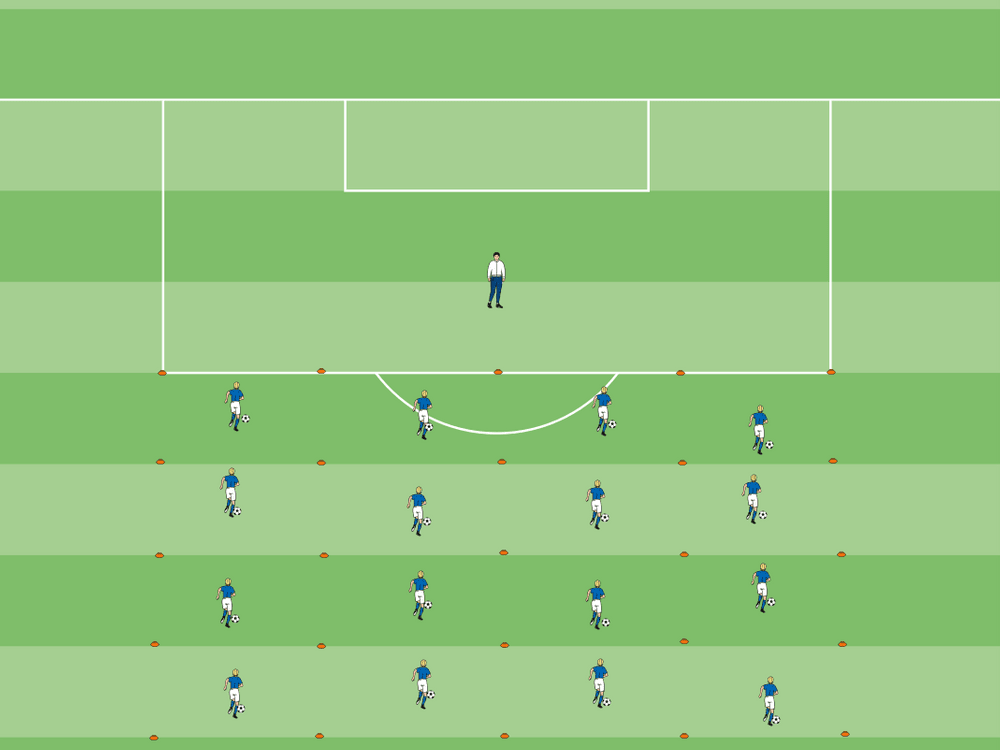
Organization
- Field measures 20v20 with each player in a five-yard square. Feel free to increase distances or create two separate grids to increase the space between players.
Gameplay
This is a nice warm-up, lasting approximately 15 minutes, but, if the situation calls for prolonged training in confined areas, feel free to extend it. Call a direction, such as “forward, left” and all the players will dribble to that cone. Use turning variations, such as an inside or outside of the boot chop, to change direction. Run the exercise for a couple of minutes and then give a short recovery. Before using another ball manipulation skill, you can run the skill statically for a minute, have the players do a Beast Mode Soccer type exercise or do some body-weight fitness training.
Coaching points
- Quickness of the turns
- Proper application of technical skills
- Channelling internal motivation to run the exercise at 100% intensity.
- Proper form in fitness exercises
Exercise 2 – Fitness Circuit
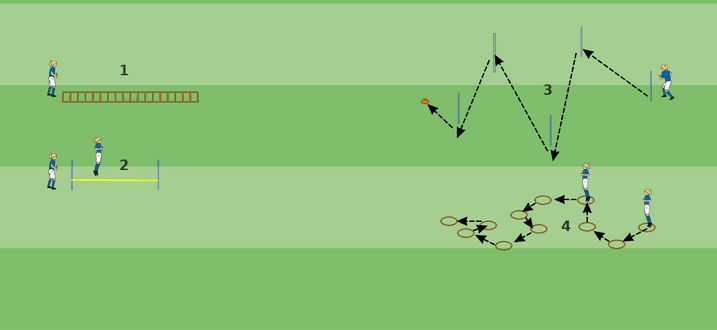
Organization
- Properly distanced equipment with small groups per station
- Station 2 is two agility pole with tape connecting them. Caution tape is both cheap and readily available at hardware stores.
- Station 3 places agility poles at varying distances so that players must adapt their footwork to the different lengths
- Station 4 is a rings pattern with various types of jumps
Gameplay
At the top of the image, stations 1 and 3 are designed for quickness and speed. There are dozens of agility rope exercises online. Find your favourites and use them. At station 3, different types of movement and changes of direction can be used.
Our two exercises at the bottom of the image focus on plyometrics. At station 2, set the height of the rope for the level of the athlete. Knee height is typically best. Ideas include diagonal jump, 180 and 360-degree leaps and one-footed hopping. At station 4, match the distances to the player’s ability while using similar jumping variations to what you see at station 2.
Coaching points
- Optimizing movement mechanics
- Coach acceleration and deceleration techniques
- Stability and balance in the jumps. Make the players hold their balance for a second between jumps.
- A holistic understanding of body movement
Exercise 3 – Shuttle runs with an opponent
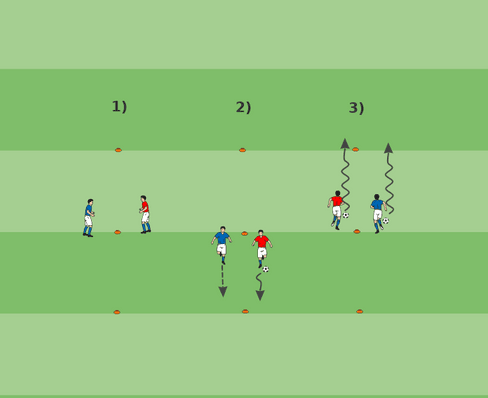
Organization
- Three cones per line with ten yards between them
- Appropriate distances between stations (at least five yards)
Gameplay
This is a 1v1 race to the cones at the left or right of the two players. Above, the attackers are highlighted with red shirts. Station 1 is the core exercise. The red player works in a feint and sprints past one of the two far cones. The players then return to the centre cone and switch roles, leaving blue to attack in the second round. Do this for one minute while keeping track of wins. To keep the defender from stopping early, give a bonus point if the attacker wins by more than two steps.
At station 2, the attack has a ball. For the final progression, make both players dribble. This one is simple in setup and seemingly simple in terms of outcome, but the coaching points at the key.
Coaching points
- Watch the opponent’s hip movement and quad activation for directional and timing cues
- For attackers, don’t just make a move and go. Instead, the idea, just like in a game, is to manipulate the defender’s balance and body orientation. Once either of these is compromised, then the attacker should take action. Train your players to recognise the cues for the when and where in 1v1 dribbling.
- For defenders, can you deceive the attacker into thinking you’re off-balance? If so, you can manipulate their timing.
Exercise 4 – Crossbar Challenge and Nets
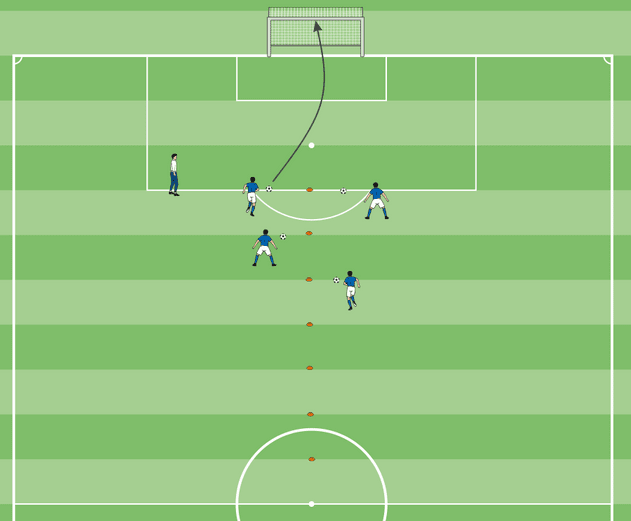
Organization
- Set the first station at the top of the box. From that starting point, set another cone every six yards. These serve as levels.
Gameplay
Use this setup to work on static technical training while offering a competitive environment. For chipping, use the crossbar challenge. If you want to work on shooting with power, driving the ball or pinging, play nets. Nets is as simple as it sounds; the ball’s first contact must be with the net, not the ground. Do that and you move to the next level. Have players take turns in rounds so that you minimize player movement in front of the goal and accurately gauge performance. Another adaption is a bending challenge from the end line, or even behind the end line.
Coaching points
- You, as the coach, need to know the minute details of the techniques you’re trying to teach. Do this work ahead of time.
- Make the players describe, in detail, what that specific technique should look like. If they think about it early, they’re more likely to keep thinking about it during the exercise.
- Improve one small aspect of the strike with each take. Make the players identify what’s right or wrong with their strikes. Once they have the strike they like, make sure they think about what made it such a good strike, then encourage replication.
Ball contamination allowed, but no contact
Progressing to phase two, we’re now looking at scenarios in which ball contamination is allowed, so passing and shooting exercises are back on the agenda. Coaching patterns of play, giving the players the visual for tactical concepts you want to implement is an option at this stage. There’s also the possibility of passing patterns that, while not implementing a tactical concept, force the players to make quality touches in a static environment. Include a time limit or multiple stations to introduce an element of competition. That additional component is absolutely necessary. Without them, these patterns are ugly and totally unproductive.
Passing patterns are widely available online. Search for them in your internet browser or on YouTube and you’ll find dozens, if not hundreds, so I’ll steer clear of them here. My basic advice for passing patterns is that, make sure they mirror your coaching philosophy and the team’s tactics. If it’s not something they’ll use in a match or a pattern that’s not easily constructed under game conditions, don’t use it in your session. Also, you must find or be an external motivator. If the game is absent for the exercise, you must bring some other form of pressure instead.
The three exercises offer an idea of the types of games you can play while eliminating contact. Each requires the players to play within non-contact zones. Since the attackers are not under direct pressure from the defending team, you want to time these exercises so that players are encouraged to rack up as many points as possible during their turns in attack.
For the defending team, the emphasis is interceptions, not tackling. Place them in environments where they can still use proper, high-quality defensive work, but taking away the possibility of the tackle. Help them to focus on the correct passing cues the opponent will show them. Help them become a little faster in identifying the when and where of the pass.
Exercise 1 – Cross the river
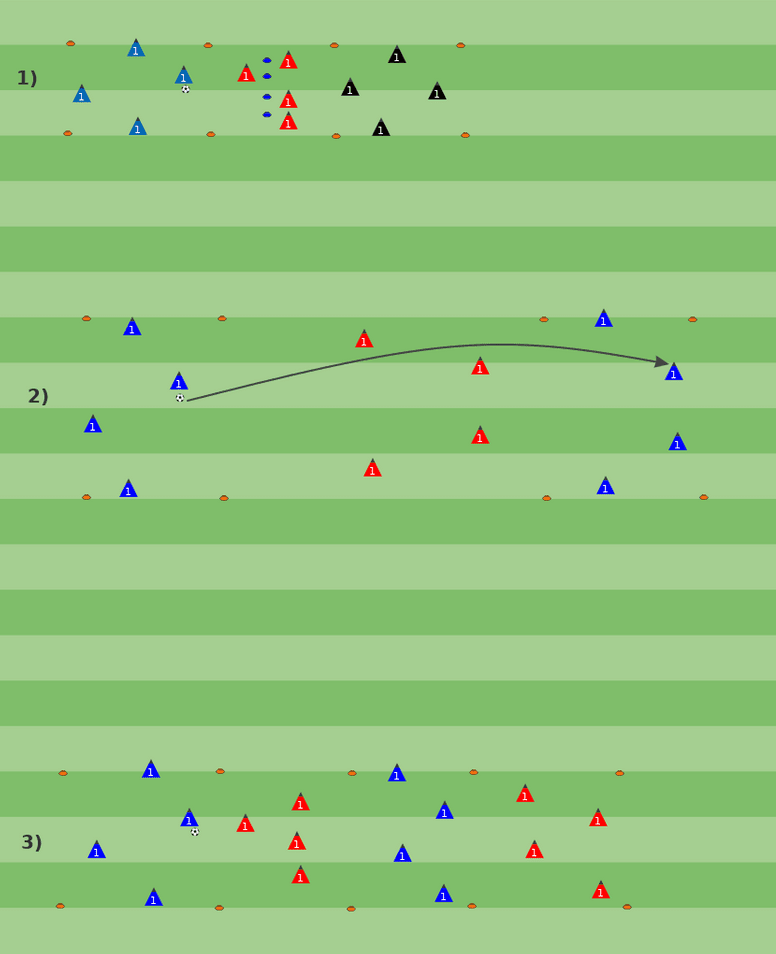
Organization
- In the 1st and 3rd exercises, you’ll want to match the width of the playing area to the skill level of your players, but I find 10 yards typically works. In terms of the length of each box, seven yards will suffice. In total, that gives you a 21×10 area for the first variation and 28×10 for the 3rd. 4v4+4
- For the 2nd exercise, you must again determine the right fit for the skill level of your team. Each endzone can measure 10 yards, then factor in a middle section of 15 yards for lower-level teams, 30 to 40 yards for higher-level groups. Know that the savvy players will mostly defend deep, so you’re primarily working on chipping in this exercise. To build more opportunities for pings and firm, intermediate range passes you can increase the width of the playing area and decrease the length. 4+4v4+4
Gameplay
1) and 3) Each team defends in three-minute increments. A completed pass from one endzone to the other equals a point against the defensive team. Like golf, the fewer the points, the better the score. Once each team has defended once, compare points to find the winner.
2) Play a three minute round. Like the other two exercises, the team with fewer points wins. A point is scored when a pass is completed between the team’s two zones.
When defenders win the ball, the coach restarts play with the attacking team. To add extra incentive in these exercises, give the teams one point for playing around the defence and two points if they split the defenders.
Coaching points
- Correct body orientation to connect actions
- Setting teammates to play across
- Short movements off the ball to offer passing lanes for the 1st and 2nd attackers
- Watch for proper technical execution, especially with more challenging techniques
- Pressure, cover and balance for defenders
- Communication of the defenders. Use simple, quick terms like “slide left”, “I’m pressure” and “step”.
Exercise 2 – Midfield defending rondo
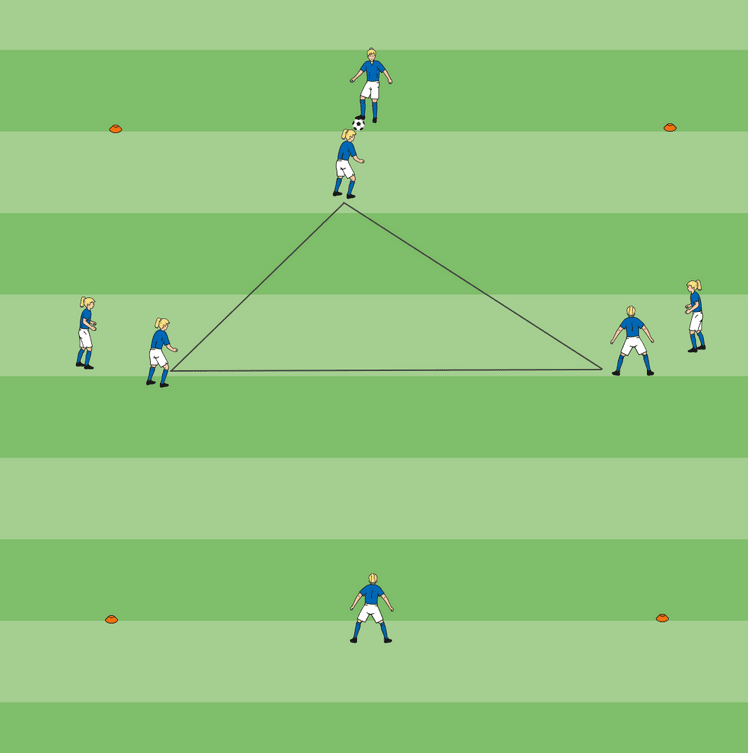
Organization
- Field measures 10v10 with
- Each of the four attackers playing between the cones (feel free to have them take two steps back to ensure social distancing and avoid contact) and three defenders on the inside of the square
Gameplay
This is a simple rondo for the attacking team as the primary objective is to simply keep the ball. To ramp up the intensity, offer points for split passes (only for the passer and receiver) and for x number of passes completed (for all four attackers), so maybe 5 for lower-level teams and 10 for higher-level. Coaching the three defenders to press as a midfield unit is the top priority of the exercise. When defenders win the ball, the coach restarts play with the attacking team. 3-minute rounds per defensive team.
Coaching points
- For defenders, pressure to deny a central pass and cover to eliminate wide options
- If the defence spends too much time chasing, coach structure, especially asking how far wide the two cover defenders need to start in order to eliminate the threat
- If the attackers struggle, ask about how the angles they’re offering impact the play
Exercise 3 – High press rondo
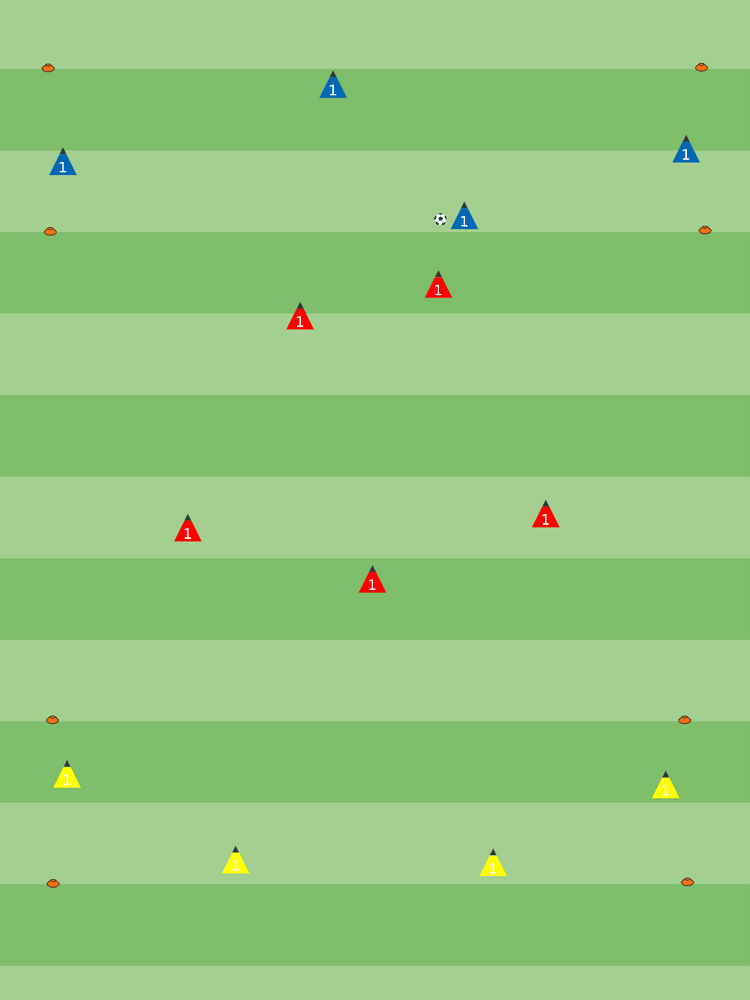
Organization
- Field measures 10×25 yard endzones with an ability appropriate length for the middle zone. A range of 20 to 40 yards will do. Matching the length to a technical objective is also a nice guide. For passes on the ground, use a shorter distance. For pings, intermediate is best. For chipping, bending or drive, longer distances work best.
- Five defenders in the middle, situated in a 3-2 or 2-3 to replicate your team’s press. More options deep increase the difficulty level for the attackers.
- Four attackers per side
Gameplay
Pass the ball from one endzone to the other for a point. Points go against the defensive team with fewer points, so fewer points is better. When defenders win the ball, the coach restarts play with the attacking team. Keep the defensive team in the middle for a three minute round.
Coaching points
- Heads up to identify opportunities to play across. Coach them to take a look even if the play is going short.
- Techniques for bringing the ball out of the air
- Play short to unlock the long pass
- Angles of approach for the highest defenders
Soft contact allowed
Finally, we have soft contact. Think poke tackles instead of full challenges. The most difficult aspect of this phase is the competitiveness of the players. Trust me, they will want to put in a tackle. As you set up your exercises, have the ideas in the back of your mind that your exercises should make it very difficult to dribble. If players are forced to prioritise passing, then you’ll see more interceptions than tackles.
The additional point is that you don’t necessarily want to encourage soft contact from a defensive standpoint. One thing I noticed early on is that my players were picking up really bad tackling habits. Fortunately, I think I caught the issue early and made the adjustment. Just keep that in mind as you develop your sessions. In this phase, focus almost exclusively on tight spaces with limited opportunities to dribble. It limits the attackers’ options, but it also protects the tackling technique of your players.
This stage is not far removed from full contact. Just know that if you allow space for the dribble, the rate of tackles will increase as that becomes the most realistic chance of winning the ball back.
Exercise 1 – Target game
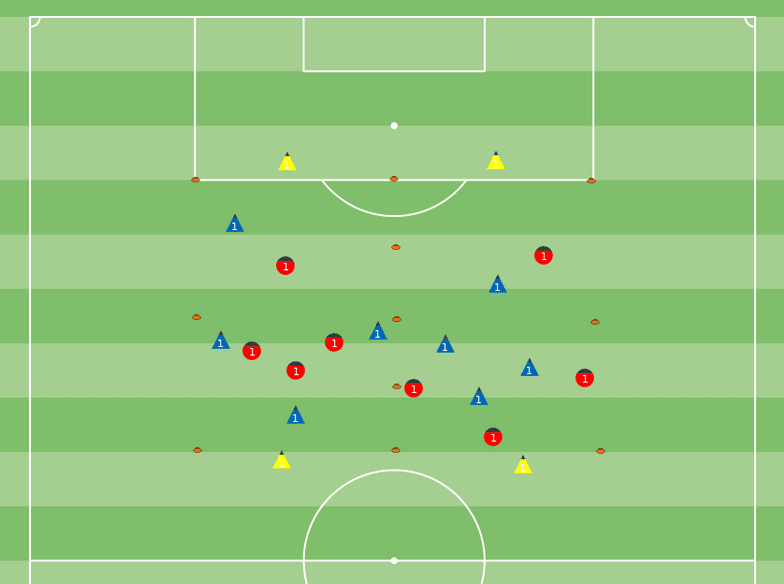
Organization
- Field measures 30v10. I like a narrow pitch in this exercise to eliminate space for the dribble and let the game conditions force the players to look for penetrating passes.
- 4v4+2 neutral target players
Gameplay
Teams earn points by passing to the target players with a “make it take it” approach. In the game on the left, let’s say the blue triangles complete a pass to the high target player. Since the target player is neutral, he would simply pass to the same to that played the ball to him and the field switches (blue now looking to play the bottom target. To incentive line-breaking passes, give a bonus point if the attacking team completes the pass to the target from its defensive half. For cleaner play, don’t allow points for any passes to the target player that are above knee height. Eight-minute rounds.
Coaching points
- Correct body orientation to connect actions
- Width and, more importantly, depth in attack
- Rotations to free runners behind the lines
- Angles of support
- Line breaking passes with support underneath. Connect the set to playing the third runner.
Exercise 2 – Give and Go Game
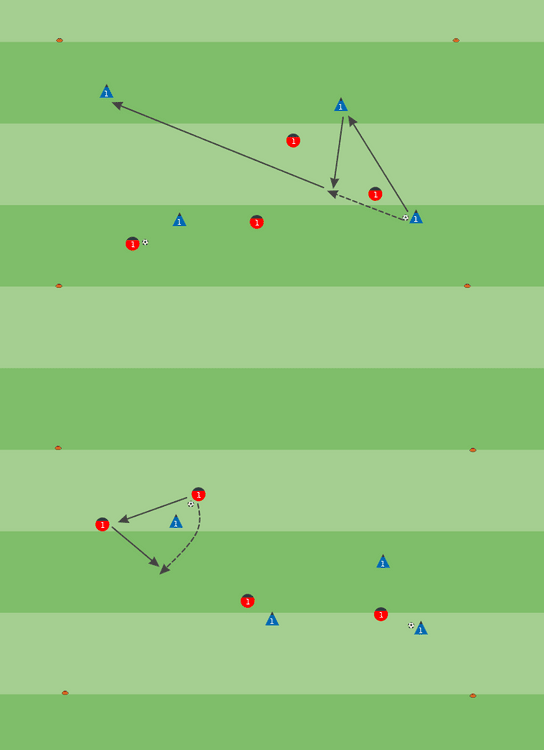
Organization
- Field measures 15v15. Feel free to increase distances or create two separate grids to increase the space between players.
- 4v4 per grid. Allow for a neutral player if the players don’t have success after the first round.
Gameplay
Games durations can be based on point totals (first to 10) or time (3 minutes). Two balls in play per grid. A team earns a point each time they complete a give and go. They must beat a defender to earn a point. Play is continuous, so encourage players to beat one opponent and move straight to the next.
A variation with large sides, such as 8v8, is to knock-out all the opponents. If a player has a give and go completed around them, they’re out. The endgame will feature one player hugging the touchline and running for their lives. Give the attacking team one minute to knock the final opponent out. If they can’t do it, the team with the single person in play wins.
Coaching points
- Correct body orientation to connect actions
- Pinning opponents to free running space behind them. Teach them to engage the defender before releasing the pass.
- Awareness of the whole pitch. Check shoulders and keep a mental image as best possible. This is a very fast-moving game, so that picture does change rather quickly.
- Defending against the give and go by going with the initial passer rather than following the pass. One common error is that defenders turn inside in the direction of the pass rather than outside in the direction of the runner. Teach defenders to buy themselves time, space and contact by tracking the runner, not the pass.
Exercise 3 – Back-to-back goals game
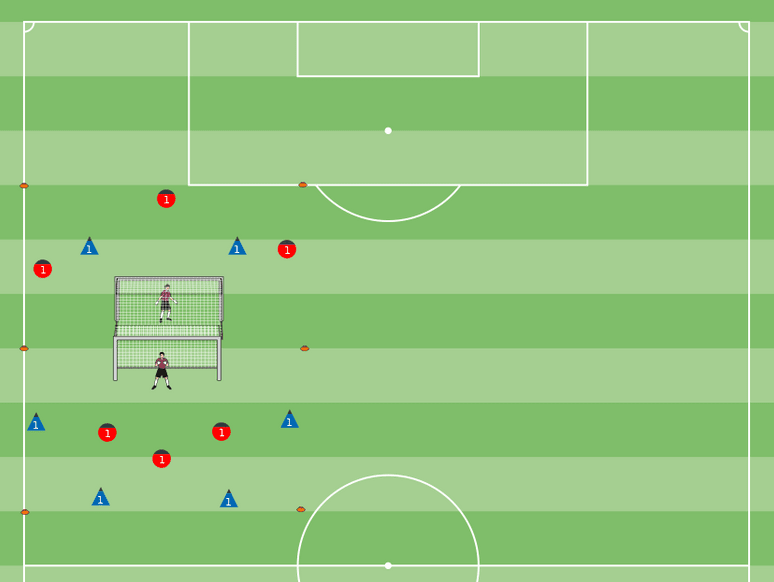
Organization
- Field measures 50v30
- Two goals (or one pop-up goal) are placed back-to-back in the middle of the playing area.
- 3v3 per half, but the attacking team can send a 4th player across as their team holds the ball in its attacking zone. Players can dribble or pass from their defensive half into the attacking half.
Gameplay
I’ve shamelessly stolen it from Gordon Ramsey, the former academy director of Motherwell in Scotland, and my players have really enjoyed this game. A goal equals a point and the team with the most points win. Use 8-minute rounds. To add another element to the game, when the ball goes out of play, have players outside of the grid to send crosses as the form of re-entry.
When defending, the goal is to win the ball and pass it around or over the goals to your attacking teammates on the other side of the pitch. If you make the pitch a little wider, you can even have dedicated, neutral wingers running the touchline.
Coaching points
- Defensively, compact shape in front of goal with quick transitions to break pressure
- Reinforce proper finishing techniques and ideas
- Techniques for bringing the ball out of the air
- Dismarking and combination play to create the shot
Conclusion
With zero cross-contamination, sessions are particularly difficult, especially in the pod setting. However, if the players are allowed to move freely in their assigned area of the pitch, the exercises in the first section allow for more enjoyment and skill development. Let’s face the music, with our players limited socially, designing enjoyable sessions is more important than ever.
If your club or region allows for some degree of cross-contamination, the options greatly increase. Even if the limit is ball contamination only, players can still engage in possession-based games, which they’ll really enjoy since its closer to the game they know and love. Another way to end practices is to make them competitive. Under early restrictions, the crossbar challenge, nets, bending competition and pinging challenge (with caution tape spanning the posts to create a knee to hip scoring area) were huge hits.
Ultimately, empathise with the players, understanding that they miss the game, both for the competition and social structure, as much as you do. This COVID-19 isolation has hurt them deeply. Help them to have fun while developing their talent and you’ll ensure regular participation and ease the burden of our global condition.





Comments